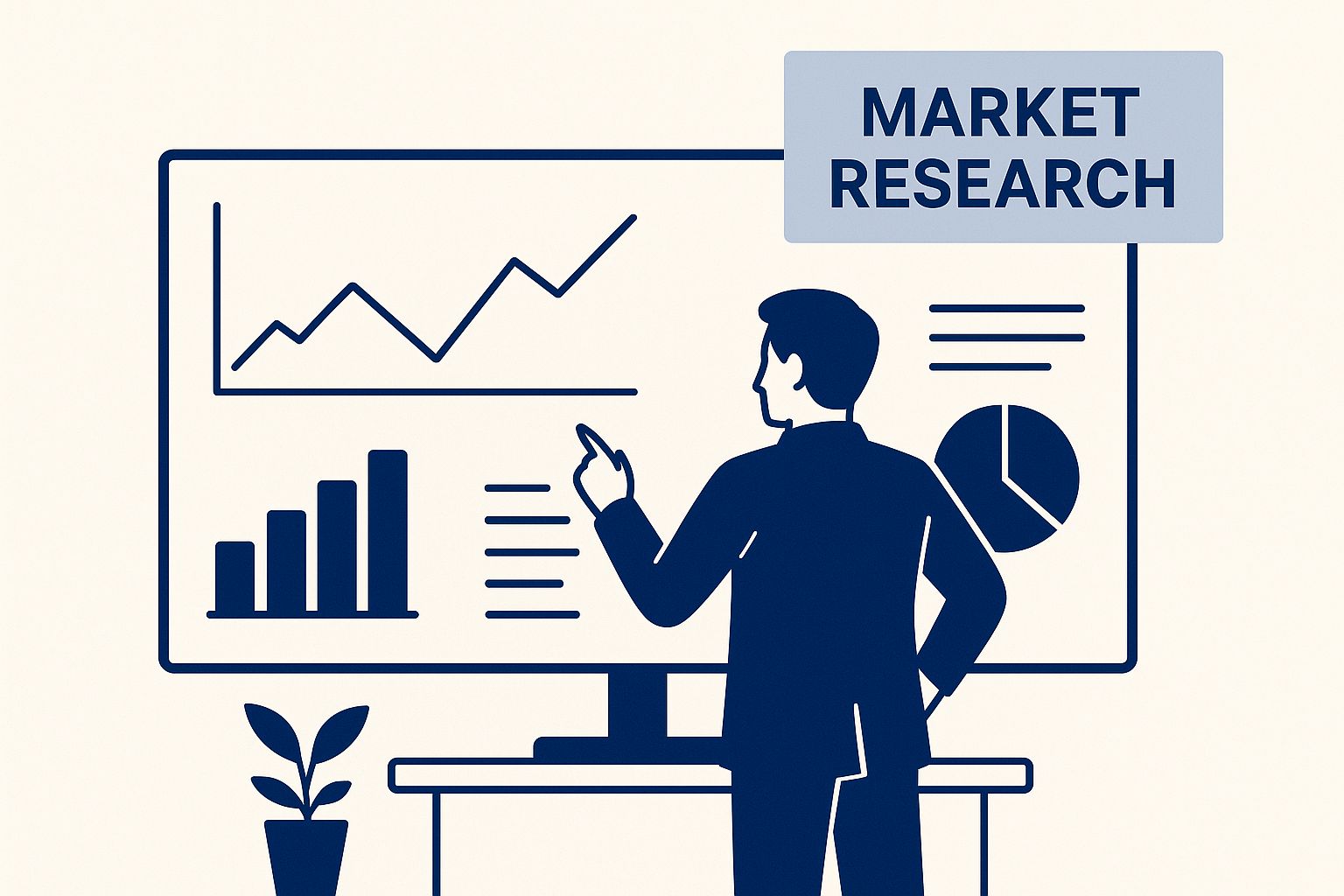Market opportunity identification is the disciplined process of locating unmet needs and underserved segments where a business can create unique value. For decision-makers in commercial insurance, it is the strategic hunt for new avenues of growth. This could involve launching an innovative product, entering a new geographic market, or refining service delivery to a specific industry vertical. It is the methodology for converting raw market data into a distinct competitive advantage.
Decoding Market Opportunity Identification
This process is a core strategic function, analogous to how a seasoned underwriter assesses a complex risk portfolio. It requires moving beyond simple data collection to actively identifying signals within a noisy market. The objective is to spot profitable patterns and anticipate client needs before competitors do.
This forward-thinking approach is essential for navigating the significant shifts impacting the insurance industry, from climate-related perils to rapid technological advancement.
For underwriters, brokers, and risk managers, mastering market opportunity identification is no longer optional. It is the engine that drives sustainable growth in an increasingly volatile commercial insurance landscape. The goal is to shift from reacting to coverage requests to proactively engineering the solutions that clients will require to manage emerging risks.
Moving from Insight to Action
A strategic approach requires a deep analysis of the forces shaping clients' operational environments. A critical first step is mastering the process of identifying customer needs, as this forms the foundation of any credible opportunity analysis. This comes down to answering several key questions:
- Where are the emerging risks that currently lack adequate coverage solutions?
- Which industries are experiencing rapid growth, and what are their unique liability exposures?
- How can proprietary data be leveraged to identify underserved segments within an existing book of business?
By methodically pursuing these answers, insurers can uncover fertile ground for new product development. Examples include parametric policies for specific climate perils or specialized cyber coverage for high-growth technology sectors. This is how abstract market trends are converted into tangible, profitable business lines.
This entire discipline hinges on robust, data-driven market research—a sector projected to reach $150 billion globally by 2025. This figure underscores the high value businesses place on accurate data to guide strategic decisions. The firms that excel at integrating data analytics into their market opportunity identification process are the ones consistently outperforming the market. You can explore further insights on this trend through market research industry trends on research-network.co.
The Four Pillars of Opportunity Analysis
Identifying a viable market opportunity is a structured, repeatable process. For decision-makers in commercial insurance, breaking this down into four distinct pillars provides a clear framework for discovering the next profitable venture. Each pillar is a critical component, and together, they provide a comprehensive view of the market landscape.
This disciplined analysis is what separates underwriters, brokers, and risk managers who merely react to market shifts from those who proactively shape their portfolios for future growth.
This visual demonstrates how structured market research, built upon these pillars, forms the foundation for effective business strategy.

Image
As the image illustrates, dedicated research enables decision-makers to cut through market noise, analyze complex data, and translate insights into a clear, actionable plan.
Pillar 1: Customer Analysis
The most valuable opportunities are often latent within a customer's unmet needs. Customer analysis is the process of methodically identifying these gaps. For insurers, this means looking beyond existing policies to understand the new risks clients face in high-growth sectors like renewable energy or biotechnology.
Key questions to address include:
- What new operational risks are emerging in clients' supply chains?
- Are there coverage gaps for intangible assets, such as data or intellectual property, that are not being addressed?
- Which customer segments are underserved by standard, one-size-fits-all products?
Answering these questions provides a clear roadmap for innovation. It is the basis for creating specialized products that solve real, pressing problems and command the higher margins associated with them.
Pillar 2: Competitor Intelligence
Understanding what competitors offer is standard practice. Identifying what they *fail* to offer is where opportunity lies. Competitor intelligence is not merely a list of rivals; it is a strategic dissection of their product portfolios, pricing models, and, most importantly, their service gaps.
An effective tactic is to pinpoint where a competitor’s product is inadequate. For instance, if a large carrier offers a generic cyber policy, a more agile insurer can develop a specialized product for a niche like healthcare IT. By offering superior coverage for specific regulatory risks (e.g., HIPAA), the smaller firm can turn the competitor's broad strategy into a targeted advantage.
This pillar is about identifying vulnerabilities in the competitive landscape and positioning your offerings as the superior solution.
Pillar 3: Market Trend Forecasting
Market trends are the powerful currents shaping the future of risk. Proactive insurers do not just react to these trends; they anticipate them. In commercial insurance, the two most significant currents are climate change and technological advancement.
Forecasting involves connecting macro-level trends to specific product opportunities. It means seeing how rising sea levels will create demand for new property insurance solutions or how the proliferation of IoT devices necessitates new forms of liability coverage. Success in this area depends on the quality of the underlying data; understanding how a high-fidelity approach like Sentinel's accuracy methodology can sharpen risk assessment and forecasting is critical.
Pillar 4: Regulatory Scanning
The regulatory environment is a constant source of both challenges and opportunities. New compliance requirements often create an immediate, non-negotiable need for new insurance products. Regulatory scanning is the practice of monitoring legislative and regulatory changes to identify these emerging needs ahead of the competition.
For example, new environmental regulations might mandate that businesses carry specific pollution liability coverage. An insurer that anticipates this change can develop and launch a compliant product first, capturing significant market share before competitors can react. This pillar transforms a compliance burden into a first-mover advantage.
Connecting Global Shifts to New Insurance Markets

Image
Effective market opportunity identification is about connecting macro-level global trends to tangible, underwritable risks. Macroeconomic indicators should be viewed not as abstract figures, but as a roadmap indicating where capital is flowing, where infrastructure is being developed, and where new insurable risks are emerging.
For insurance professionals, the key is to translate these broad economic shifts into precise market entry strategies.
One of the clearest signals is foreign direct investment (FDI). When capital crosses borders to fund new manufacturing facilities, large-scale renewable energy projects, or technology hubs, it creates immediate, concentrated demand for sophisticated commercial insurance products. This is the frontline of opportunity for proactive underwriters and brokers.
For example, a surge of FDI into a developing nation's manufacturing sector is a direct indicator of future demand for a suite of commercial coverages. This is a clear example of how global trends impact the specific industries we serve.
By tracking global investment flows, you can anticipate demand for specialized products like political risk, supply chain disruption, and construction all-risk policies. This process transforms abstract economic data into a concrete pipeline of high-value business opportunities.
From FDI Patterns to Underwriting Opportunities
Consider a real-world scenario: a significant wave of FDI is directed toward Latin America for large-scale solar and wind energy projects. This single trend creates multiple, distinct insurance needs that can be anticipated:
- Construction Phase: Immediate demand will arise for Builder's Risk and Erection All Risks (EAR) policies to cover the physical construction of new facilities.
- Operational Phase: Once operational, these projects will require property insurance, business interruption, and specialized equipment breakdown coverage.
- Geopolitical Stability: Substantial foreign investment will increase demand for political risk insurance to protect assets from government actions or regional instability.
- Supply Chain Integrity: The transport of high-value components, such as wind turbines and solar panels, will create a need for marine cargo and supply chain insurance policies.
This methodical approach allows insurance carriers to get ahead of the market, designing and positioning products *before* demand becomes widespread and commoditized.
A Case Study in Global Capital Flows
Recent investment patterns validate this approach. FDI data reveals significant market opportunities in Latin America and the Caribbean (LAC), a region that attracted nearly 49% of FDI inflows to emerging economies in 2023.
This influx, which surpassed Asia for the first time, signals a strategic shift in global capital allocation. For insurers, LAC's success in attracting this investment is a clear indicator of where the next wave of commercial risk will emerge. You can analyze these global opportunity trends from the Milken Institute for deeper insights.
Finding Profitable Niches Through Data

Image
While macro-level market analysis provides strategic direction, the most profitable opportunities are often found through granular data analysis. This approach uncovers underserved niche markets that larger competitors frequently overlook.
These are the segments where an insurer can build a defensible market position, command higher margins, and avoid the intense pricing pressures of mainstream markets. Effective market opportunity identification requires moving beyond broad industry trends to analyze specific demographic and behavioral patterns. Understanding *how* a potential client operates—not just their industry—enables the design of products that solve their precise problems.
Translating Niche Success to Insurance Innovation
Successful B2C companies provide a powerful blueprint for this strategy. For instance, NightOwl, a delivery service for late-night workers, grew its revenue by 125% in its first year by solving a problem for the 78% of night-shift workers dissatisfied with late-night dining options.
Another example is SeniorTech, which identified a $4.2 billion market of seniors seeking more user-friendly technology. These cases offer direct analogies for insurance product innovation.
- The "NightOwl" Opportunity: The growth of the gig economy has created a new nocturnal workforce with unique liability needs. Data on their work hours, locations, and common risks can inform the development of specialized policies for delivery drivers or freelance creatives operating outside traditional business hours.
- The "SeniorTech" Opportunity: The aging population is increasingly online, creating clear demand for new insurance products. This includes personal cyber policies covering phishing scams or tech support insurance that can be bundled with property coverage plans.
From Raw Data to High-Margin Products
Uncovering these opportunities requires a structured approach. The objective is to connect demographic information (age, income, location) with behavioral data (purchasing habits, online activity, operational patterns) to build a comprehensive profile of an underserved group.
The core principle is straightforward: where a distinct, unaddressed need is shared by a specific group, there exists an opportunity to create a high-value, low-competition product. This is how data is transformed from a simple asset into a strategic tool for growth.
To effectively leverage data and identify these profitable niches, it is essential to refine your practical business intelligence strategy. A robust BI framework ensures that your team can collect, analyze, and, most importantly, act on these valuable insights.
This focused approach is also highly effective for generating high-quality leads. For more on this topic, review our guide on [how to generate insurance leads](https://insurtech.bpcorp.eu/blog/how-to-generate-insurance-leads-1753166881063) by targeting specific, high-need segments.
Turning Climate Risk Into a Competitive Advantage
The insurance industry has historically viewed climate change as a defensive challenge—a massive, unpredictable threat to be managed. However, the escalating frequency of climate-related events is more than a disruptor; it is the single greatest opportunity for innovation the market has seen in decades.
The strategic pivot is to stop viewing climate change through a reactive lens of loss mitigation and start using market opportunity identification to transform this threat into a powerful engine for growth.
This requires a shift from defense to offense. Instead of only modeling losses from the next wildfire, proactive carriers are developing the products and services required in a world of increasing climate volatility. The demand for climate resilience is no longer a niche concern but a mainstream commercial imperative.
From Peril to Product
The core of this strategy is to methodically connect specific climate perils to unmet commercial needs. Every new risk creates a corresponding gap in the market—a gap that can be filled by an insurer with the foresight to address it. This approach not only opens new revenue streams but also solidifies the insurer's position as an essential partner in an uncertain future.
Consider these real-world applications:
- Parametric Policies for Wildfire Zones: Traditional indemnity policies can be slow. Following a fire, a business needs immediate capital, not a lengthy claims adjustment process. A parametric policy, triggered by a clear metric—such as a fire’s perimeter reaching a specified proximity—delivers rapid, transparent payouts, enabling the business to begin recovery immediately.
- Risk Mitigation Consulting: Instead of just selling a policy for a warehouse in a flood zone, offer a consulting service alongside it. Provide expert advice on structural reinforcements, supply chain diversification, or the implementation of real-time weather monitoring. This creates a new fee-based income stream while simultaneously reducing the risk in your own portfolio.
- Underwriting the Green Transition: The global shift to renewable energy is driving massive infrastructure investments. Offshore wind farms and large-scale solar installations present unique, complex risks not adequately covered by traditional policies. Carriers that develop the expertise to underwrite these ventures are tapping into one of the fastest-growing markets in the world.
This shift fundamentally alters the value proposition. Insurers evolve from being reactive responders after a disaster to proactive partners in building business resilience *before* a crisis occurs.
Understanding the full [business impact of climate change](https://insurtech.bpcorp.eu/blog/climate-change-business-impact-1753686460888) is the first step, but tangible value is created by building this new class of products.
A Framework for Climate-Driven Opportunities
To execute this strategy, decision-makers need a simple, repeatable process. A clear framework that connects a climate peril directly to a commercial risk—and then to a tangible insurance opportunity—creates a roadmap for product development and strategic investment.
The following table provides a starting point for mapping specific climate threats to concrete market needs.
Mapping Climate Risks to Insurance Opportunities
A framework connecting climate-related perils to potential insurance product and service opportunities, helping decision-makers prioritize development efforts.
| Climate Peril (e.g., Wildfire, Sea-Level Rise) | Associated Commercial Risk | Potential Insurance Opportunity |
|---|---|---|
| Intensifying Hurricanes | Port closures and supply chain disruption for logistics companies. | Parametric business interruption coverage triggered by storm category and location. |
| Prolonged Droughts | Crop failure and water shortages for agricultural businesses. | Specialized yield-guarantee insurance or water rights liability coverage. |
| Sea-Level Rise | Gradual property damage and reduced asset value for coastal real estate. | Long-term resilience bonds or specialized flood-exclusion buyback policies. |
By adopting this opportunity-first mindset, underwriters, brokers, and risk managers can do more than just manage climate risk. They can actively monetize it. This is how to build a sustainable competitive advantage in an industry being fundamentally reshaped by climate change.
Answering Your Top Questions
Executing market opportunity identification raises practical questions for underwriters, brokers, and risk managers. Here are direct answers to the most common queries to bridge the gap between strategy and implementation.
How Can Smaller Insurers Compete?
How can a smaller insurer compete with large carriers in identifying new market opportunities?
Smaller insurers win by focusing on niche markets that larger carriers are too slow or inefficient to serve effectively. The advantage is not in broad market data but in agility and deep expertise within specific industries or regions.
For example, a mid-sized insurer can aim to become the leading provider for an emerging sector like drone logistics. It can develop specialized underwriting knowledge, move faster on product development, and build stronger client relationships. By leveraging targeted data, smaller firms can serve these niches far more effectively than a larger, more generalized competitor.
What Are the First Steps to Get Started?
Where should a firm begin when establishing a formal opportunity identification process?
First, assemble a cross-functional team comprising representatives from underwriting, claims, sales, and strategy. Diverse perspectives are crucial from the outset. This team's initial task is to clearly define the company's strategic goals and risk appetite.
Next, invest in foundational data and analytics tools, starting with industry reports and economic trend data. Finally, launch a pilot project. Select one promising area—a new industry vertical or an emerging climate risk—and apply a structured framework like SWOT or PESTLE analysis. This allows the team to learn the process and demonstrate early wins before scaling the initiative.
A structured, step-by-step approach is critical. It prevents the team from becoming overwhelmed by data and ensures that initial efforts are tied to tangible business outcomes, building momentum for future projects.
Identifying new opportunities is also an excellent method for fueling the sales pipeline. To learn how this works in practice, explore proven strategies for effective [insurance lead generation](https://insurtech.bpcorp.eu/blog/insurance-lead-generation-1755249706896) designed for today's competitive landscape.
What Role Does AI Play in This?
How does artificial intelligence factor into market opportunity identification?
AI serves as a powerful analytical engine capable of processing vast datasets—economic indicators, claims histories, satellite imagery, regulatory filings—to identify patterns and correlations a human analyst would likely miss.
For an insurer, AI can model future risk landscapes, predict which industries are poised for growth, and pinpoint specific coverage gaps. For example, an AI can analyze news feeds and geospatial data to flag regions with increasing wildfire risk, signaling an opportunity to develop new parametric insurance products for that area.
Ultimately, AI automates the time-consuming initial analysis, freeing up human experts to focus on higher-value activities: making strategic decisions and innovating on new products.
---
At Insurtech.bpcorp.eu, we turn climate intelligence into your competitive advantage. Our Sentinel Shield platform delivers real-time, geo-targeted leads of businesses impacted by climate events, enabling you to connect with high-intent prospects at their moment of greatest need. Discover how to transform climate risk into tangible opportunities by visiting us at https://insurtech.bpcorp.eu.